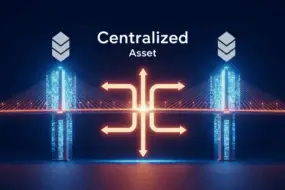
It is not a thing to be surprised that cryptocurrency trading has revolutionized the financial world, offering new opportunities for traders and investors alike. Two of the most popular trading methods in the crypto market are spot and futures trading. Both have their unique characteristics, benefits, and risks involved. And for you to be profitable in this space? You have to understand these key differences in order to navigate the volatile world of cryptocurrency.
This article will dive into the intricacies of spot and futures trading, highlighting their main distinctions and how traders can leverage them for their financial advantage.
What Is Crypto Spot Trading?
How Is Spot Trading Defined?
As discussed in our previous article, spot trading involves buying and selling cryptocurrencies for immediate delivery without respite or delay. This means that transactions are settled “on the spot,” with the buyer receiving the cryptocurrency instantly, and the seller receiving the agreed-upon amount in fiat or another cryptocurrency. The price at which these transactions occur is known as the spot price or market price.
How Does Spot Trading Work?
In spot trading, transactions are straightforward. A trader places an order on a cryptocurrency exchange like Bitunix, specifying the amount and price of the cryptocurrency they wish to buy or sell. Once a matching order is found, the trade is executed and the assets are transferred between the buyer and the seller. Spot trading does not require any technical expertise, it is mainly suitable for newbie traders.
What Are Spot Trading Benefits?
Spot trading offers simplicity which makes it easy to understand and execute, making it ideal for beginners. What also makes spot trading unique is the immediate ownership traders gain over their cryptocurrency holdings, allowing them to transfer, spend, stake, or hold it as they wish. Without the leverage and margin requirements of futures trading, spot trading literally involves little to no risk.
What Risks Come With Spot Trading?
As we all know there is the good and bad side to literally everything in life so it is in cryptocurrency trading. Below are some of the risks involved in spot trading.
- Market Volatility: The value of cryptocurrencies can fluctuate significantly, leading to potential losses. A typical example can be seen in the collapse of the FTX exchange that led to the massive plunge of its native token $FTT.
- Liquidity Issues: In less popular cryptocurrencies, finding a buyer or seller at the desired price can be challenging.
What’s a Simple Spot Trading Example?
Suppose you want to buy 1 Bitcoin ($BTC) at the current market price of $68,000. You place a buy order on a cryptocurrency exchange like Bitunix, and once a matching sell order is found, the trade is executed. You pay $68,000, and you immediately receive 1 $BTC in your spot exchange wallet.
What Is Crypto Futures Trading?
How Is Futures Trading Defined?
From the name itself “Futures” implies later date or extended period. Futures trading involves buying and selling contracts that represent the value of a cryptocurrency at a predetermined future date and price. Unlike spot trading, the actual cryptocurrency is not exchanged at the time the contract is bought or sold. Instead, traders speculate on the future price movements of the cryptocurrency.
This form of trading works best for experienced traders who have the knowledge and are conversant with spot trading already. Before venturing into futures trading, make sure you are proficient with spot trading.
How Does Futures Trading Work?
In futures trading, a trader enters into a contract to buy or sell a cryptocurrency at a future date. These contracts can be settled either physically (by delivering the actual cryptocurrency) or in cash (by settling the profit or loss in fiat currency). Futures contracts can be traded on margin, meaning traders can leverage their positions to amplify potential gains (or losses).
Leverage can amplify a trader’s profit and can also amplify a trader’s loss. Bitunix offers 125x leverage which a trader can use to capitalize on gains.
What Are Futures Trading Benefits?
- Leverage: Traders can control larger positions with a smaller amount of capital, potentially increasing their profits.
- Hedging: Futures contracts can be used to hedge against price volatility and protect investments.
- Speculation: Traders can profit from both rising and falling markets by taking long or short positions.
What Risks Come With Futures Trading?
- High Risk: The use of leverage can amplify losses, making futures trading riskier than spot trading.
- Complexity: Futures trading involves a higher level of complexity, making it less suitable for beginners.
- Margin Calls: If the market moves against a trader’s position, they may be required to deposit additional funds to maintain their position.
What’s a Simple Futures Trading Example?
For instance, you believe that the price of Bitcoin will rise in the next three months. You enter into a futures contract to buy 1 $BTC at $68,000 in three months. If the price of Bitcoin rises to $70,000 at the end of the contract, you can buy the Bitcoin at the agreed price of $68,000, realizing a profit of $2,000. Conversely, if the price falls to $66,000, you would incur a loss of $2,000.
What Are the Main Spot vs Futures Differences?
- Ownership of Assets: In spot trading, you take immediate ownership of the cryptocurrency once the transaction is completed. Meanwhile, in futures trading, you do not own the underlying cryptocurrency until the contract is settled.
- Settlement: Spot transactions are settled immediately. Futures contracts are settled at a future date, either physically or in cash.
- Leverage: Spot has no leverage, while futures allow traders to control larger positions with smaller capital.
- Risk and Reward: Spot risk is limited to invested capital. Futures trading amplifies both potential profits and losses.
- Market Participation: Spot attracts long-term investors, while futures draw professional and institutional traders.
- Trading Strategies: Spot uses strategies like HODLing and DCA, while futures involve shorting, hedging, and arbitrage.
How to Spot Trade on Bitunix in 5 Steps
- Deposit funds → USDT or crypto.
- Pick pair → E.g., BTC/USDT.
- Set order → Market/limit buy or sell.
- Confirm → Review fees and execute.
- Hold or transfer → Wallet or stake.
Spot vs Futures Quick Compare
| Aspect | Spot | Futures |
| Ownership | Yes | No |
| Leverage | None | High (125x) |
| Expiry | Immediate | Future date |
Risk Management Tips
| Type | Strategy | Tool |
| Spot | Diversify | Hardware wallet |
| Futures | Use SL | Monitor funding |
What Are Real Spot and Futures Use Cases?
Spot Trading Use Cases
- Long-Term Investment: Buying and holding crypto for the long term.
- Arbitrage: Exploiting price differences across exchanges.
- Liquidity Provision: Supporting smoother transactions and price discovery.
Futures Trading Use Cases
- Speculation: Profiting from price swings without ownership.
- Hedging: Protecting portfolios against adverse movements.
- Leverage: Controlling larger positions with less capital on Bitunix (up to 125x).
What Regulations Apply to Spot and Futures?
Spot Trading Regulations
Spot trading is generally subject to fewer regulatory restrictions compared to futures trading. Rules vary by jurisdiction. For example, the US has strict oversight, while El Salvador allows more relaxed frameworks.
Futures Trading Regulations
Futures trading is heavily regulated in markets like the United States, where the Commodity Futures Trading Commission (CFTC) oversees trading to protect investors. Requirements include reporting, margin compliance, and market integrity rules.
How to Manage Risks in Spot and Futures?
Spot Trading Risks
- Market Risk: Price volatility can cause losses.
- Liquidity Risk: Hard to execute trades in thin markets.
- Security Risk: Exchanges and wallets face hacking threats.
Risk Management for Spot:
- Diversify across assets.
- Use hardware wallets.
- Conduct research before investing.
Futures Trading Risks
- Leverage Risk: Losses amplified by leverage.
- Margin Calls: Extra funds required if markets move against you.
- Volatility Risk: Futures markets often move sharply.
Risk Management for Futures:
- Set stop-loss orders.
- Avoid over-leveraging.
- Monitor market conditions regularly.
Conclusion
Spot and futures trading each offer unique opportunities and challenges for cryptocurrency traders. Spot trading provides simplicity and immediate ownership of assets, making it suitable for long-term investors and beginners. Futures trading offers leverage and the ability to profit from both rising and falling markets, making it attractive to more experienced traders.
Understanding the key differences between spot and futures trading is crucial for making informed trading decisions. By leveraging the benefits and managing the risks associated with each method, traders can navigate the volatile world of cryptocurrency more effectively.
Whether you are a novice investor or an experienced trader, staying informed about the dynamics of spot and futures trading will enhance your ability to capitalize on opportunities. Always conduct thorough research, build a robust trading strategy, and use effective risk management techniques to succeed in this fast-moving market.
FAQs
What’s the biggest spot vs futures difference?
Spot gives immediate ownership at current price, while futures are contracts for future delivery with leverage.
Do I own crypto in futures?
No, futures speculate on price without ownership. Spot transfers actual assets.
When to choose spot over futures?
Spot for long-term simplicity and asset control. Futures for leveraging volatility or hedging.
When to choose futures over spot?
Futures for shorting, high leverage, or non-expiry contracts like perpetuals.
Which has higher risk?
Futures due to leverage and funding. Spot limits losses to invested capital.
How to hedge with futures?
Take opposite positions (e.g., long spot, short futures) to balance exposure.
Does Bitunix charge funding?
Yes, for perpetuals (every 8 hours). Spot has no funding but standard fees.
About Bitunix
Bitunix is one of the world’s fastest growing professional derivatives exchanges, trusted by over 3 million users across more than one hundred countries. Ranked among the top exchanges on major data aggregators, Bitunix processes billions in daily volume and offers a comprehensive suite of products including perpetual futures with high leverage, spot markets, and copy trading. Users can trade bitcoin and other major cryptocurrencies on the platform, taking advantage of advanced trading features. Known for its Ultra K line trading experience and responsive support, Bitunix provides a secure, transparent, and rewarding environment for both professional and everyday traders. Bitunix Academy adds structured lessons so you can build skills while you trade.
Bitunix Global Accounts
X | Telegram Announcements | Telegram Global | CoinMarketCap | Instagram | Facebook | LinkedIn | Reddit | Medium
Disclaimer: Trading digital assets involves risk and may result in the loss of capital. Always do your own research. Terms, conditions, and regional restrictions may apply.












